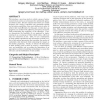Free Online Productivity Tools
i2Speak
i2Symbol
i2OCR
iTex2Img
iWeb2Print
iWeb2Shot
i2Type
iPdf2Split
iPdf2Merge
i2Bopomofo
i2Arabic
i2Style
i2Image
i2PDF
iLatex2Rtf
Sci2ools
ATAL
2010
Springer
2010
Springer
Aggregation-mediated collective perception and action in a group of miniature robots
We introduce a novel case study in which a group of miniaturized robots screen an environment for undesirable agents, and destroy them. Because miniaturized robots are usually endowed with reactive controllers and minimalist sensing and actuation capabilities, they must collaborate in order to achieve their task efficiently. In this paper, we show how aggregation can mediate both collective perception and action while maintaining the scalability of the algorithm. First, we demonstrate the feasibility of our approach by implementing it on a real group of Alice mobile robots, which are only two centimeters in size. Then, we use a combination of both realistic simulations and macroscopic models in order to find optimal parameters that maximize the number of undesirable cells destroyed while minimizing the impact on the healthy population. Finally, we discuss the limitations of these models, both in terms of accuracy, computational cost, and scalability, and we outline the importance of a...
Artificial Intelligence | ATAL 2010 | Intelligent Agents | Miniaturized Robots | Multi-level Modeling |
| Added | 08 Nov 2010 |
| Updated | 08 Nov 2010 |
| Type | Conference |
| Year | 2010 |
| Where | ATAL |
| Authors | Grégory Mermoud, Loïc Matthey, William C. Evans, Alcherio Martinoli |
Comments (0)

